This easy 15-minute Gochujang Korean Salmon is a flavorful, well-balanced meal that’s absolutely delicious. Tender salmon fillets, broccoli florets, and shiitake mushrooms are basted with a sweet and slightly spiced glaze and then broiled to perfection on a sheet pan before being topped with sesame seeds and sliced green onion. This is a tasty meal the whole family will love!
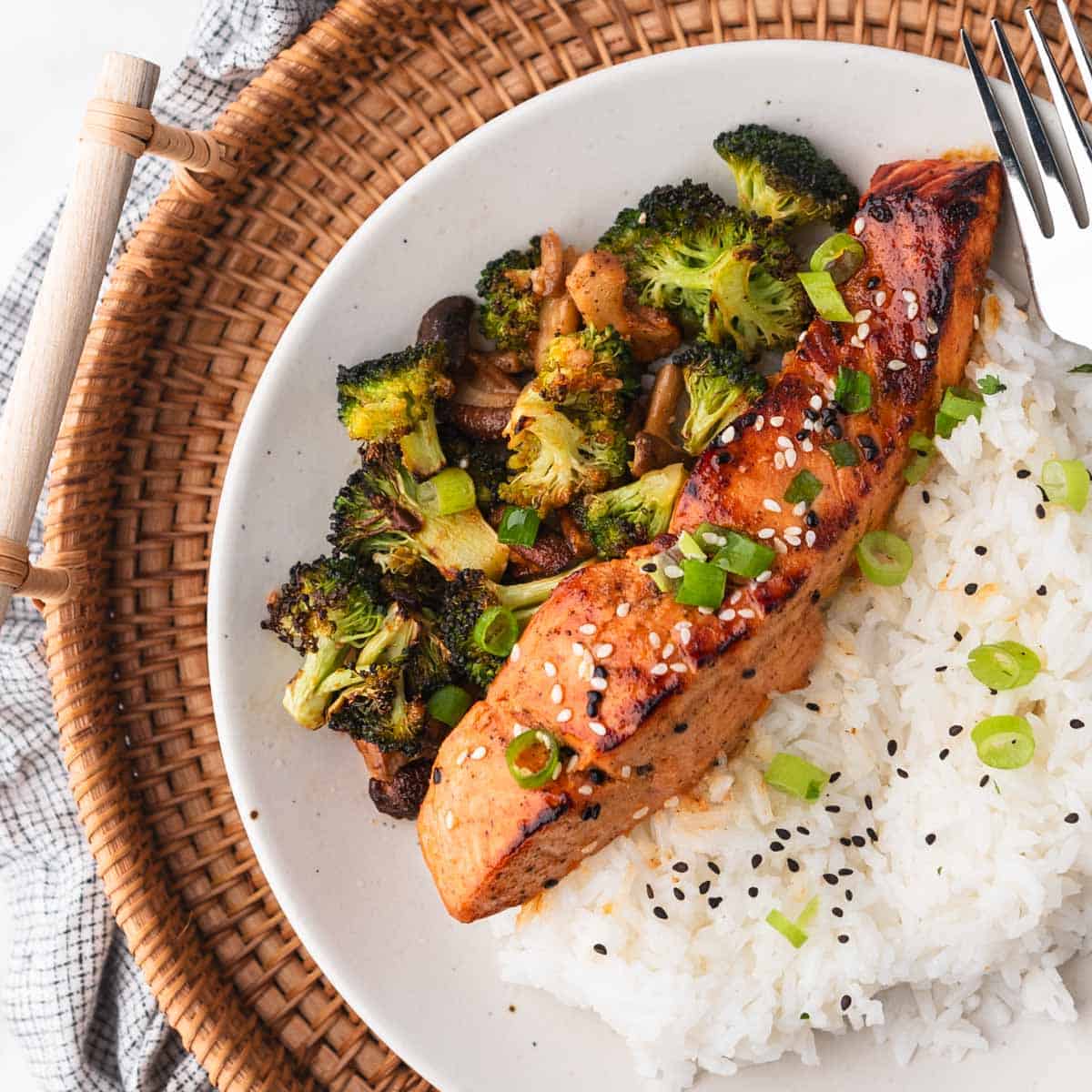
Sheet pan or one pan meals are simply the best! Throw on some protein and a few veggies and you’ve got a healthy, easy meal that is customizable to your taste preferences.
And this one for Korean salmon does not disapoint on flavor my friends. The delicious spicy ferment of the gochujang pairs so well with the rest of the sauce ingredients. It isn’t too spicy but has just enough kick to add a little heat without being overwhelming.
Plus, the veggies are cooked alongside which is always welcome in my book. I mean, whipping up some quick cooked spinach or a salad to go with the gochujang salmon isn’t that hard but some nights you just want a 15 minute and done recipe, ya know?
Why Make THIS Salmon Recipe
Broiling salmon on a sheet pan makes for a tender yet crispy piece of salmon, the perfect combination of textures. The honey in the marinade helps crisp up the salmon creating the ultimate sweet and salty taste explosion while the gochujang adds a bit of a kick.
Here are my favorite things about this easy meal that you’ll love too:
- Fast cooking time – the salmon cooks up in less than 10 minutes!
- You can meal prep the sauce over the weekend so it’s ready to go any night of the week.
- Cooking the vegetables and salmon together makes for a faster meal and an easier clean up.
- This recipe is versatile so you can modify the veggies or use a different kind of protein if you like.
- The umami flavor in this Korean-inspired recipe is so savory, with a delicious blend of ingredients.
- It’s healthy and those omega-3 fatty acids are great for your body and mind.
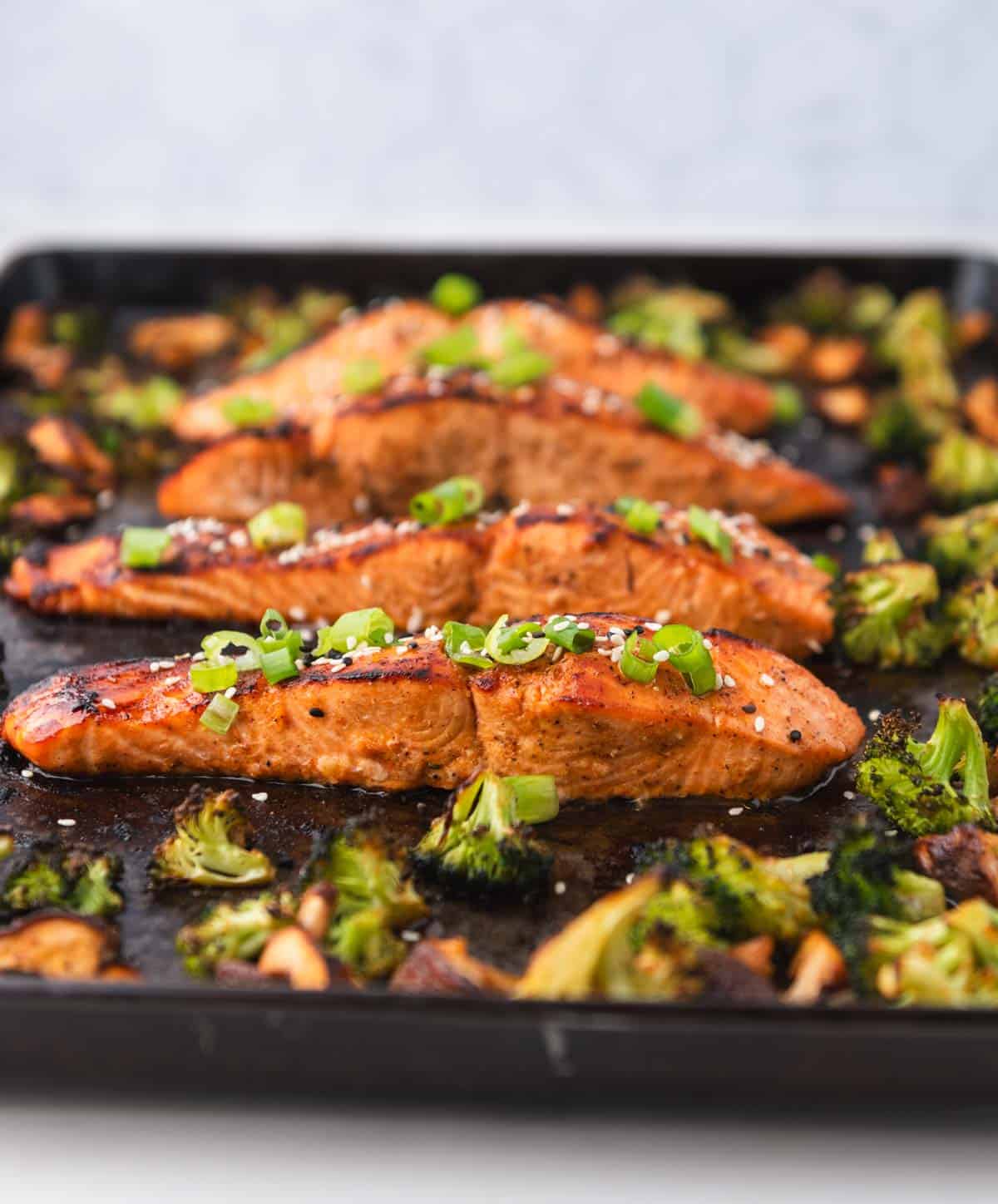
Ingredients and Substitutions
Most of the ingredients to make this salmon recipe can be found at local grocery stores. You may need to make a special trip to an Asian market or one that specializes in Korean food to find the gochujang but once you make the trip you’ll have it on hand for future recipes.
- broccoli – chop fresh broccoli into florets or buy them already prepped. Bok choy, green beans, asparagus, sliced red pepper or sugar snap peas are a good alternative.
- shiitake mushrooms – shiitake mushrooms, halved, add to the Asian flavoring of this recipe but if you have a hard time finding them you can use any type of mushrooms, cut down to about an inch in size.
- salmon fillet – use salmon fillets, sliced against the grain into 4 pieces. Salmon steak would work fine here too.
- avocado oil – you’ll need oil for rubbing onto the vegetables and salmon. I like avocado oil for it’s mild flavor and high smoke point instead olive oil but the cook time is so quick it won’t matter as much here.
- Salt and pepper – add salt and pepper to taste. I recommend a good sea salt or Himalayan salt. Freshly ground black pepper is always great but pre-ground is totally fine.
Gochujang sauce
- gochujang – gochujang paste is a spicy Korean chili paste. Most grocery stores carry it now in the Asian foods aisle but if not, Amazon or an Asian market will have many varieties of this Korean condiment. I use a gluten-free gochujang that I love.
- mirin – Japanese rice wine, mirin, adds a touch of sweetness to the sauce. You can substitute another mild flavored cooking wine in it’s place.
- rice vinegar – rice vinegar has a sweet and tangy taste which adds balance to the flavor of this sauce. You can usually find rice vinegar in the oil and vinegar section of the grocery store. It’s great to have on hand for other dishes but you can substitute white vinegar, apple cider vinegar or red wine vinegar in it’s place.
- tamari or soy sauce – either tamari or soy sauce add that salty flavor to the gochujang sauce. If you are looking for a gluten free option, tamari is best. I like to use a low sodium tamari or soy sauce and adjust the amount of salt accordingly. If you’re avoiding soy, you can substitute coconut aminos but may need to add more salt and the end result will be sweeter either way.
- honey– honey adds sweetness to the sauce which helps to caramelize the salmon as it cooks. Maple syrup or agave syrup are good substitutes. You can even swap in brown sugar as long as it fully dissolves.
- minced garlic – you can use store bought minced garlic or mince your own fresh garlic.
- toasted sesame oil – toasted sesame oil adds more richness and Asian flavor to the recipe. This can be found at your local grocery store in the oil section. Regular untoasted sesame oil is fine to swap in too.
Garnish
- green onion – sliced green onions, also known as scallions, add a pop of color and flavor to the salmon.
- sesame seeds – sesame seeds are a great garnish that add flavor and texture. For a more intense flavor, you can toast them beforehand or add them to the salmon before broiling.
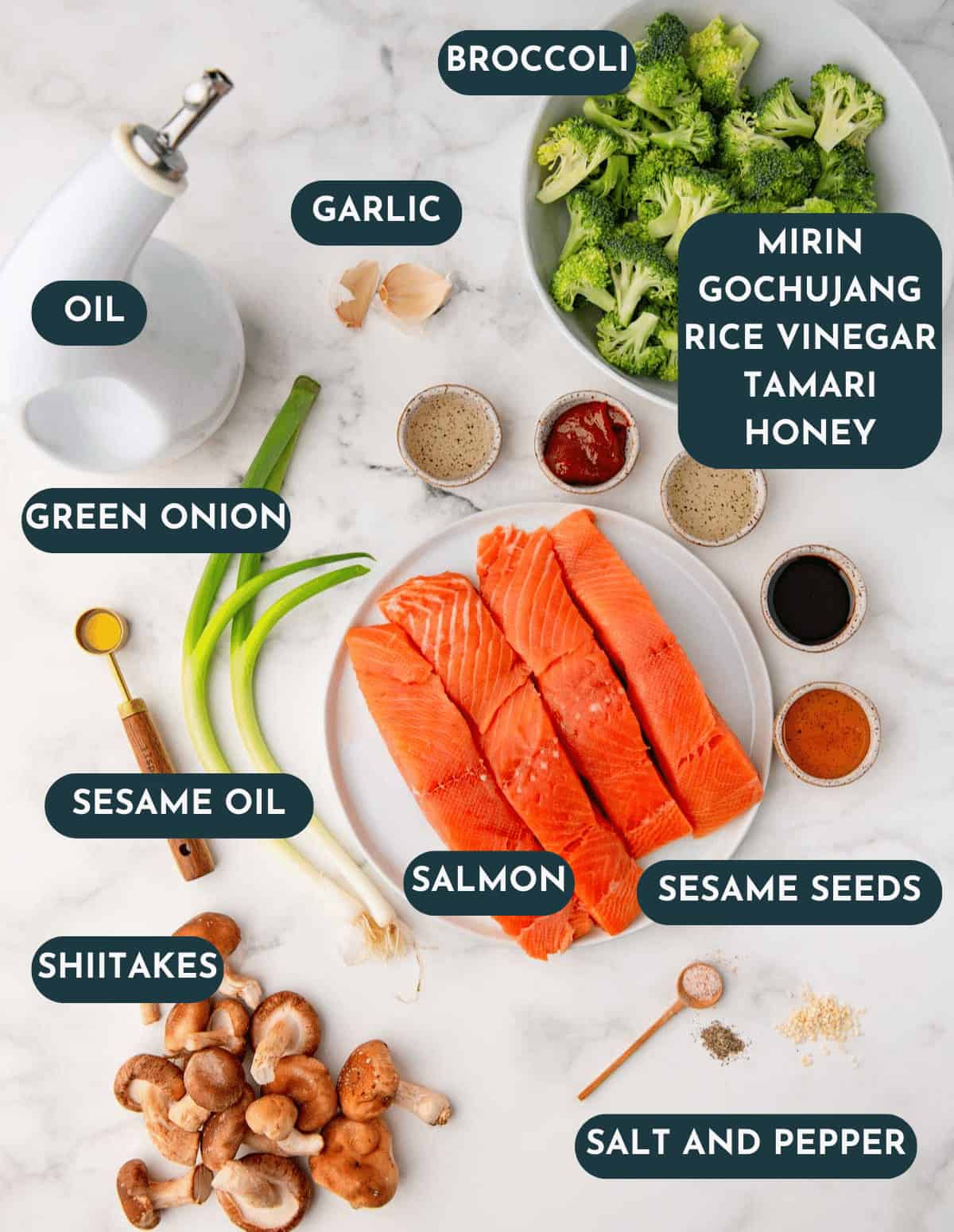
How to Make Korean Salmon
- Preheat the broiler and move one of the oven racks to the top portion of the oven.
- Whisk the sauce ingredients in a small bowl (gochujang, mirin, rice vinegar, tamari, honey, garlic, and sesame oil) and set aside.
- Rub the broccoli florets and shiitakes with avocado oil and sprinkle with salt and pepper. Pour in some of the spicy Korean sauce you just made (about 2 Tablespoons) and toss to coat the veggies.
- Dry the salmon with paper towels and rub it with oil. Sprinkle each piece with salt and pepper, making sure to evenly coat each side of the fish, not jut the top.
- Place salmon and vegetables on a rimmed baking sheet. I recommend lining with parchment paper to make clean up a bit easier. Alternatively you can spray the baking sheet with cooking spray or coat with some of the avocado oil to help keep the sauce from sticking or just plan to soak the pan.
- Using a grill brush or pastry brush, to coat the salmon in the gochujang sauce.
- Place the pan in the oven and broil for 5-7 minutes. Watch it carefully so it doesn’t burn!
- Remove the salmon from the oven. Garnish with green onion and sesame seeds and serve.
Tips and Tricks
Recipe Notes, Tips and Tricks
Watch the salmon carefully: Since salmon thickness varies and oven broilers have different heat levels, cook time will vary. If the salmon starts to get too dark before the interior is cooked, move the pan to a lower rack in the oven.
Test the salmon in the thickest part for doneness: When testing for doneness make sure you do so in the thickest section of the salmon as this part will take the longest to cook. The internal temperature of the salmon should be 145° F (63° C) when it is done. The internal temperature will continue rising after removing from the oven and over baking is the quickest way to ruin salmon! With salmon, it’s better to remove it a few degrees under over letting it over cook.
Simmer excess marinade as a glaze: Since the glaze has already come into contact with the salmon via the grill brush, I don’t recommend storing leftover sauce. For food safety, it’s ideal to bring the sauce to a boil before using. If you want to brush some on the salmon after it’s cooked, simmer the sauce for a few minutes in a small pan while the salmon broils and then use a clean brush or spoon to apply to the cooked salmon.
Choose even-sized fillets: When buying your salmon try to find pieces that are all consistent in terms of thickness. It is best if all the pieces are about the same size so they cook at the same pace. You don’t want to have to test each slice for doneness or have certain sections of the salmon under or over cooked.
Remove bones: When using tweezers to remove any bones from the salmon, pull gently in the direction of the bone to avoid damaging the fish.
Cooking with the skin on: If you have salmon with the skin on it is best to place the skin side down when cooking.
Storage
Salmon is always best eaten right away. That being said, these Korean salmon leftovers can be kept in the fridge in an airtight container or wrapped in aluminum foil for 2-3 days max. Leftovers will be best eaten within 24 hours though. The amount of time it will still be good depends on how fresh the fish was to begin with.
Warm leftover salmon in the microwave or air fryer, breaking into several pieces beforehand. Slow cooking methods like the oven will cause it to dry out in re-warming. It can be eaten cold or warm and makes a great lunch the next day or topping for a salad.
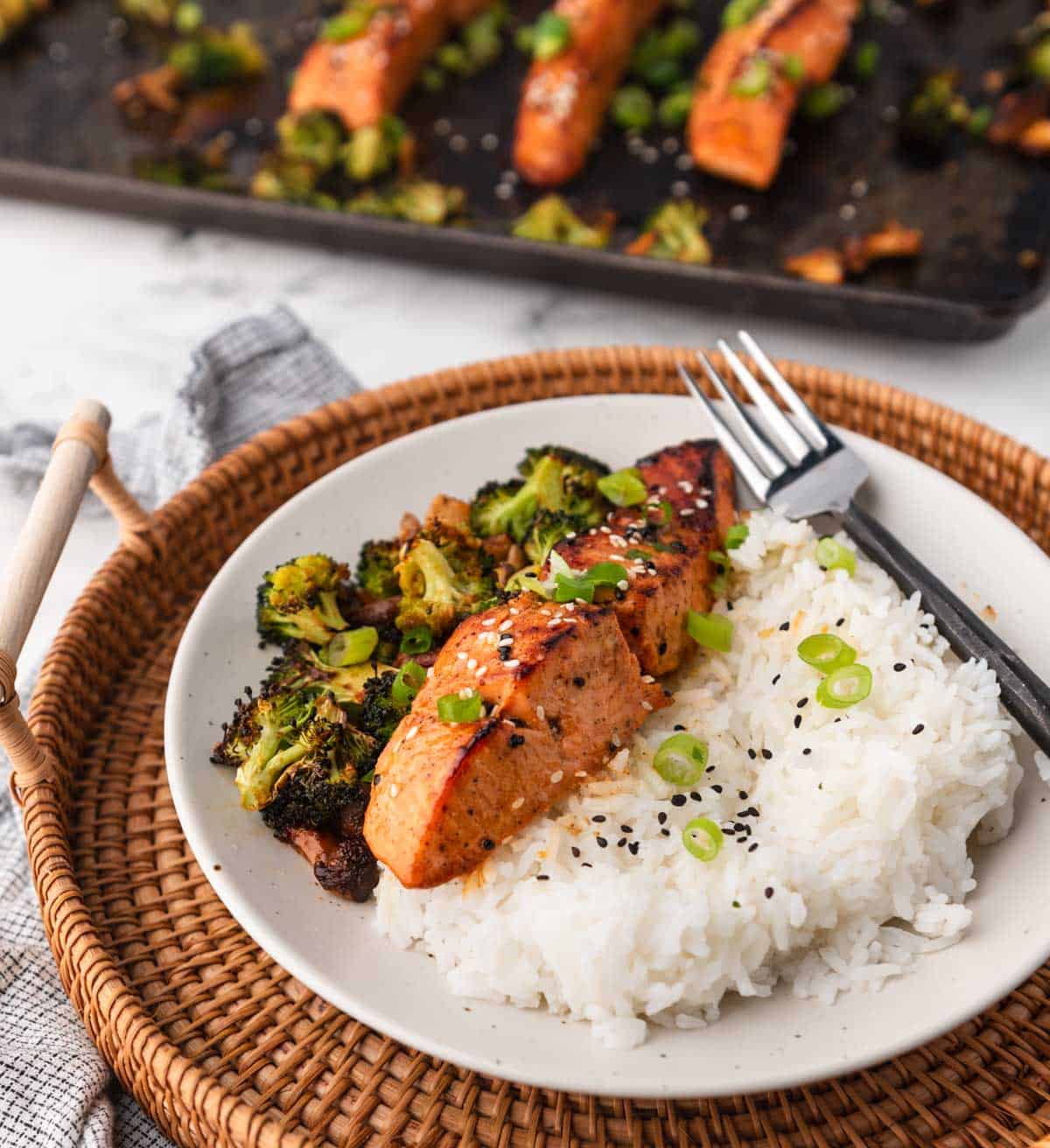
Recipe Variations
Different Flavor Variations
- Don’t like Broccoli or mushrooms? Swap them out! Quick cooking vegetables like sugar snap peas, halved baby bok choy, mushrooms, green beans, or asparagus cut into 2-inch pieces work well with this cooking method.
- Swap the gochujang with some Thai chili paste, fresh ginger and sweet chili sauce for a Thai inspired taste.
- Use another type of meat. This recipe can be made with another type of fish or even chicken tenderloins. Adjust the cooking time based on the thickness and type of protein you’re using. Broiling works well with salmon since it’s fattier so I do not recommend substituting a super lean lean or thin piece of fish.
Different Cooking Methods
Air fryer: To make Korean Salmon in the air fryer, air fry salmon and broccoli at 400° F for 6-9 minutes. Check at 6 minutes and adjust cook time if needed. Also, make sure not to crowd the air fryer and do veggies after separately if there isn’t enough room.
Pan fry. Instead of using the broiler, you can also pan fry the salmon in a large skillet in 1 Tablespoon of cooking oil Roast the vegetables separately or cook in the same skillet right after cooking the salmon. If you choose this method, sear each side for about 3 minutes on medium-high heat. You can add any remaining sauce to the skillet, let it simmer for a minute and then spoon it onto the salmon after it cooks as a glaze for even more flavor.
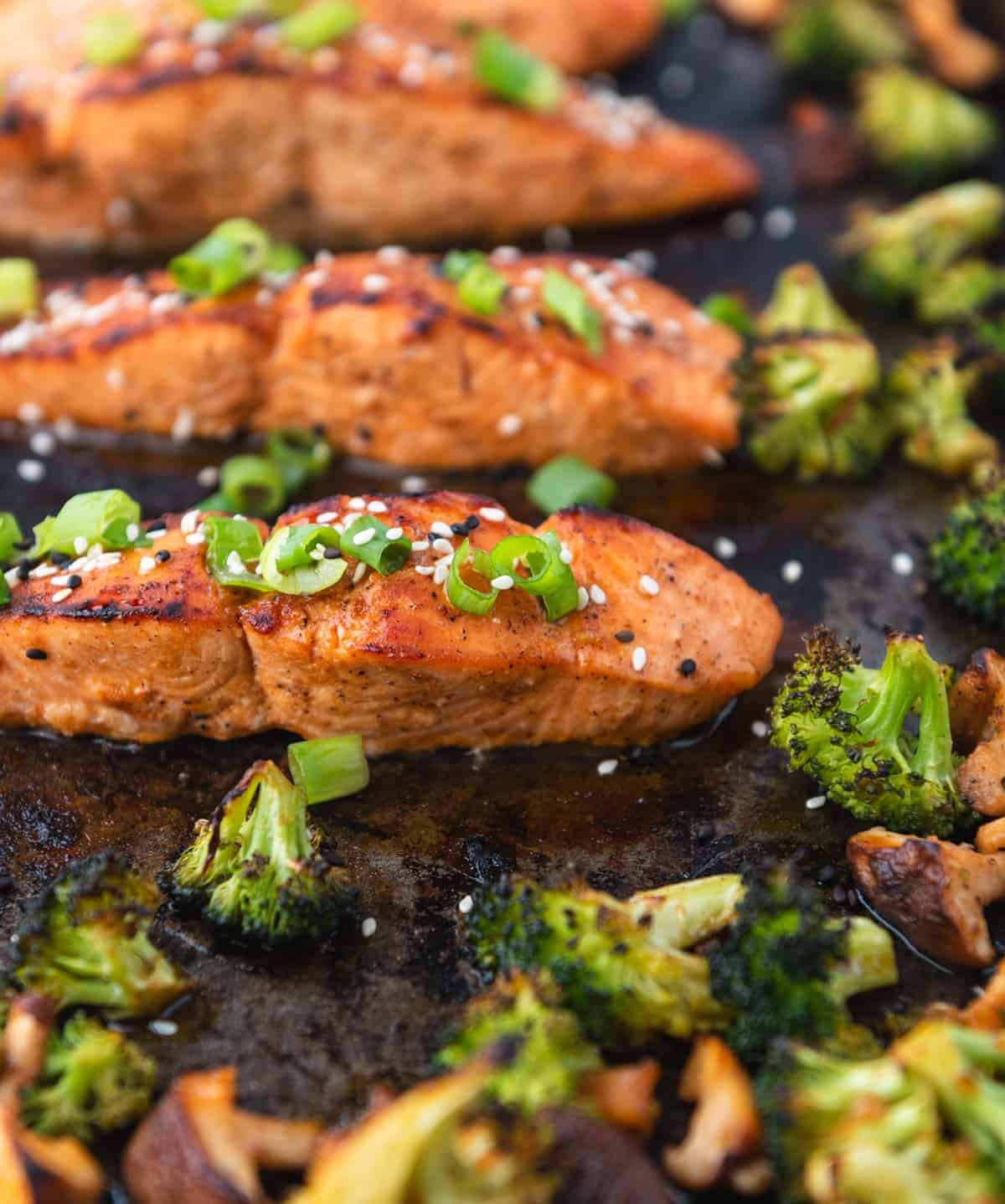
What to Serve with Korean Salmon
For this Korean salmon recipe, I made some white rice on the side but you can choose whatever you prefer. Here are some ideas to get your brain moving:
- Kimchee on the side
- Gochujang fried rice
- Coconut rice made in the Instant Pot
- Miso noodle bowls – you could even skip all the veggies in the recipe and just add the Korean salmon and veggie on top of the sauced up noodles
- Baked marinated portobello mushrooms – the flavor profiles would complement each other
Can you put gochujang on salmon?
Yes, gochujang can go directly on salmon but it is best if used as part of a marinade or glaze. This makes the flavor less intense and more balanced.
Is gochujang too spicy?
Gochujang does have some heat but you can adjust the amount you add based on your tolerance for spice. If you know you like things mild, you may want to use half the amount of guchujang listed in the recipe.
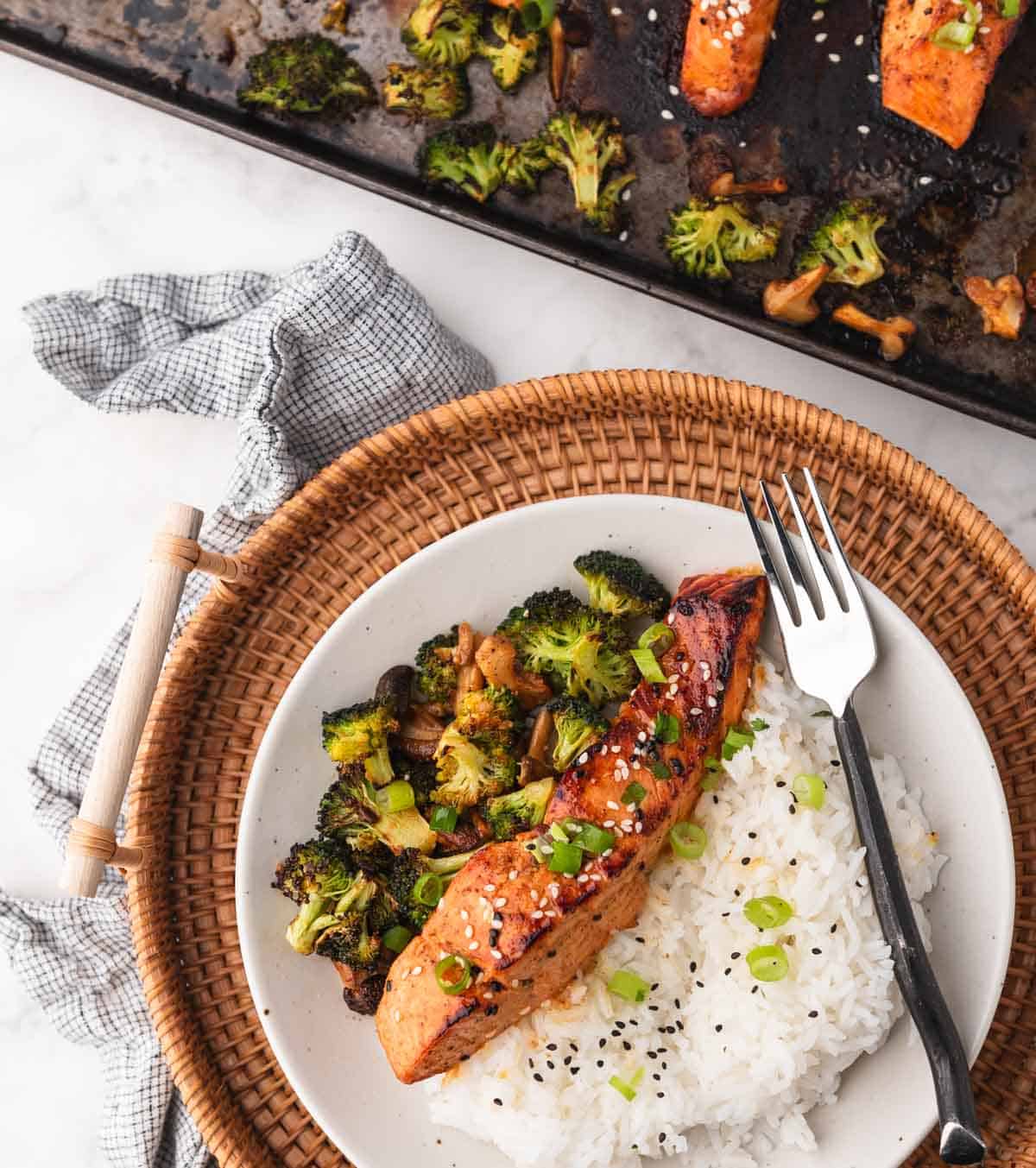
Equipment
- 1 Small bowl
- 1 Whisk
- 1 basting brush You can just use a spoon or your fingers if you don't have one
Ingredients
Salmon and Vegetables
- 3 cups broccoli florets
- 4 ounces shiitake mushrooms halved
- 1– 1 ¼ lb. salmon fillet sliced against the grain into 4 pieces
- 2 Tablespoons avocado oil divided
- Salt about 1 teaspoon
- Black pepper about 1/2 teaspoon
Gochujang sauce
- 1 Tablespoons gochujang
- 1 Tablespoon mirin
- 1 Tablespoon rice vinegar
- 1 Tablespoon Tamari or soy sauce
- 1 Tablespoon Honey
- 1 teaspoon minced garlic 1 large clove or 2 medium
- 1 teaspoon toasted sesame oil
Garnish
- Sliced green onion
- Sesame seeds
Instructions
- Start preheating the broiler and move the oven rack to be on the top row, about 6-8 inches (15cm) underneath.
- In a bowl, whisk together gochujang, mirin, rice vinegar, Tamari, honey, garlic, and sesame oil. Set aside.
- Rub broccoli and shiitakes with 1 tablespoon oil and sprinkle with salt and pepper. Pour 1-2 Tablespoons of the gochujang sauce onto the veggies and toss. Set aside.
- Use paper towels to lightly dry the salmon. Rub with 1 tablespoon oil and sprinkle each salmon piece with salt and pepper.
- Place the salmon pieces on a rimmed baking sheet. Place shiitake mushrooms and broccoli around on the edges. To make clean up easy, you can line the sheet with parchment paper first.
- Use a grill brush to liberally apply the sauce to the salmon.
- Place the baking sheet in the preheated oven and let it cook for 5-7 minutes. Since all broilers work differently, turn on the oven light or even just leave the oven door cracked open an inch to keep an eye on it. See Cook Time notes below for more details and tips.
- Remove the salmon from the oven. Garnish with green onion and sesame seeds and serve.
Notes
Nutrition
did you make this recipe?
Make sure to follow on Pinterest @feastingnotfasting and on Instagram @feastingnotfasting
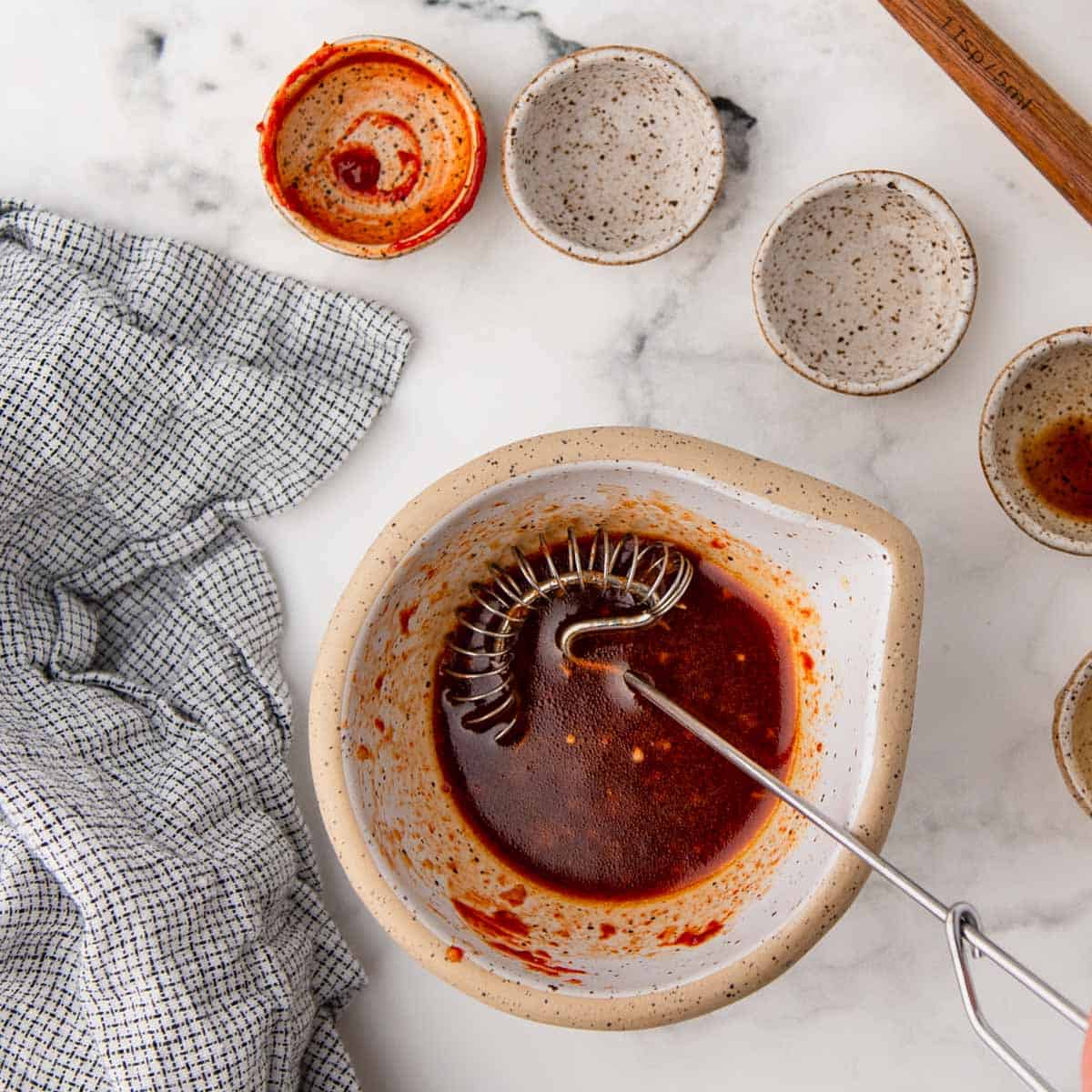
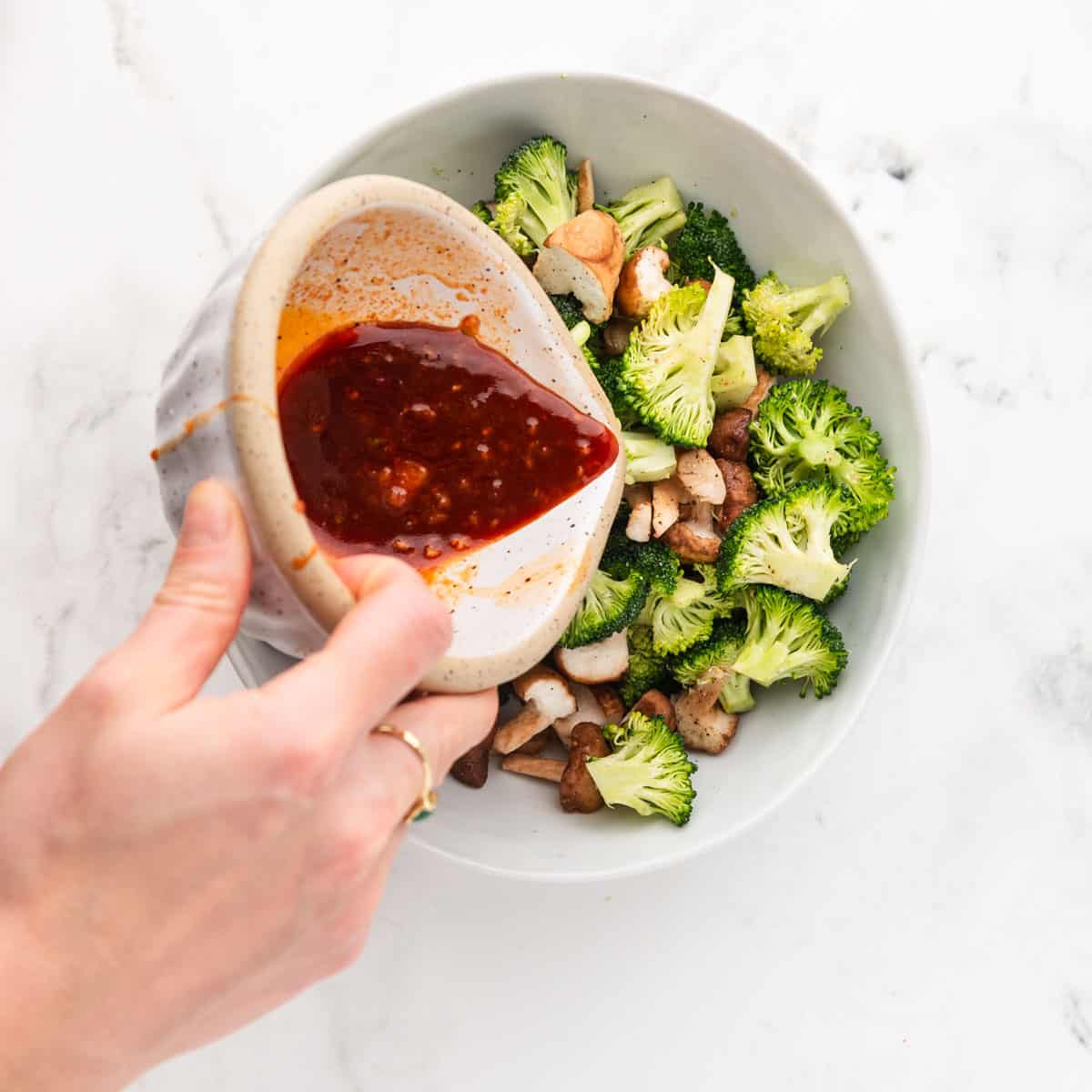
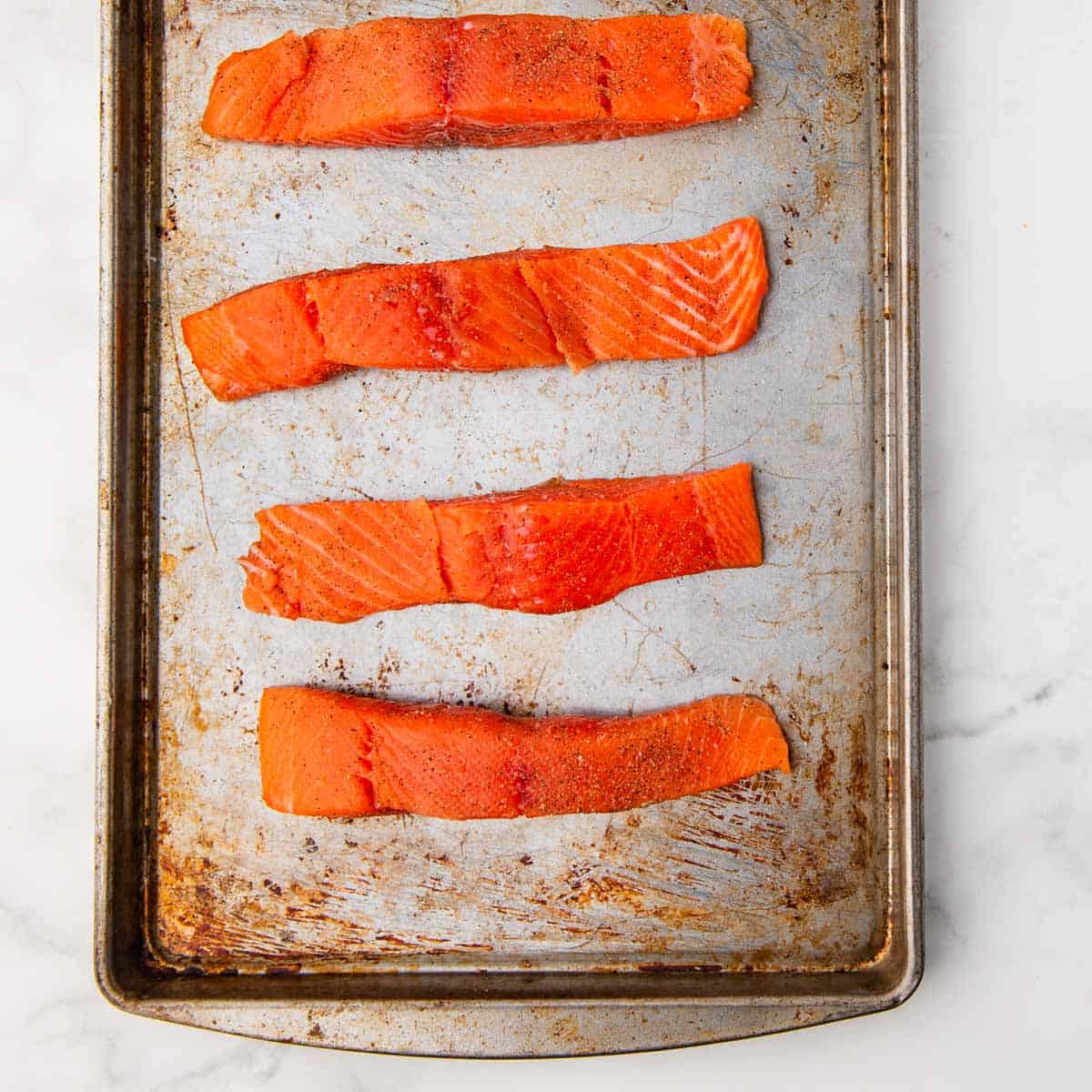
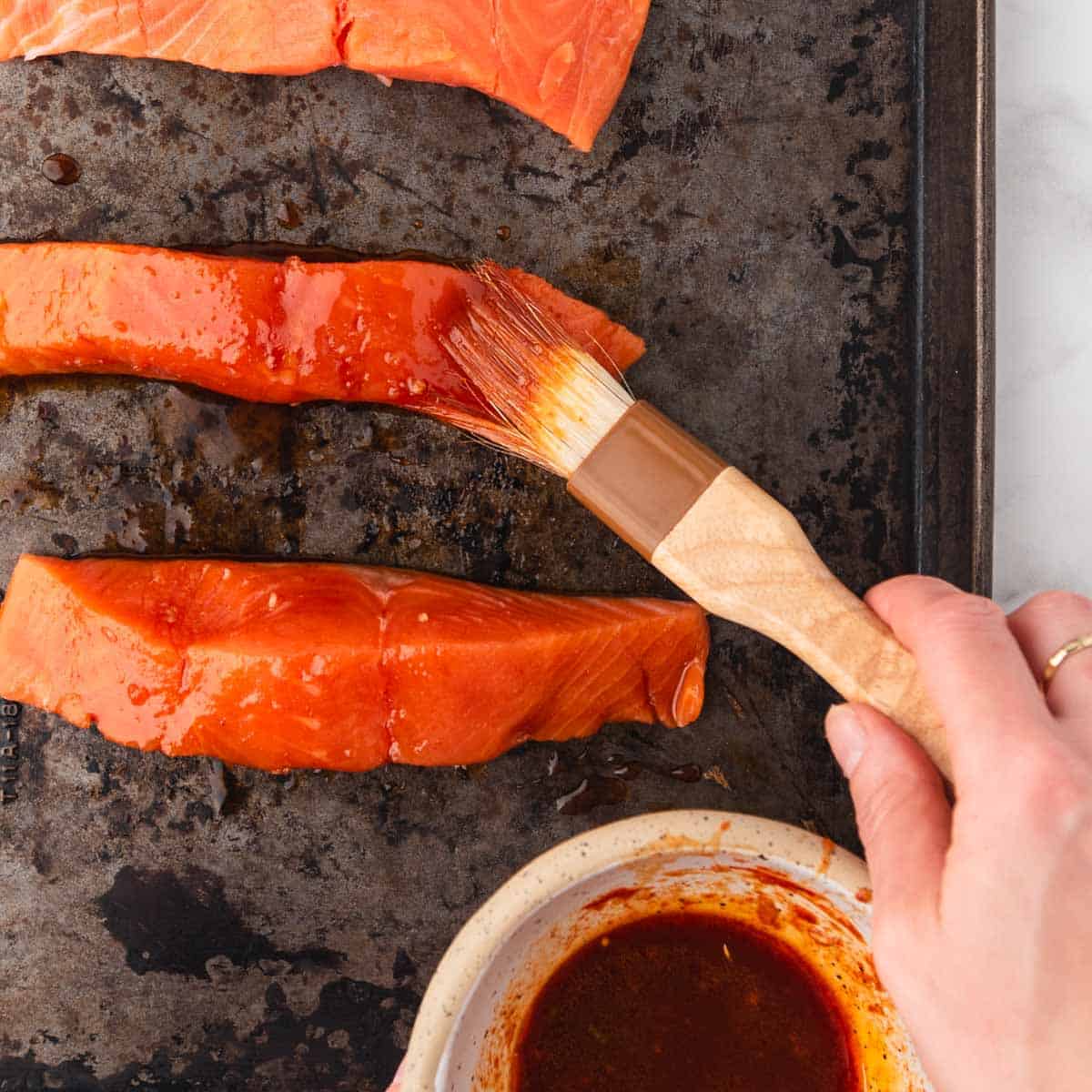
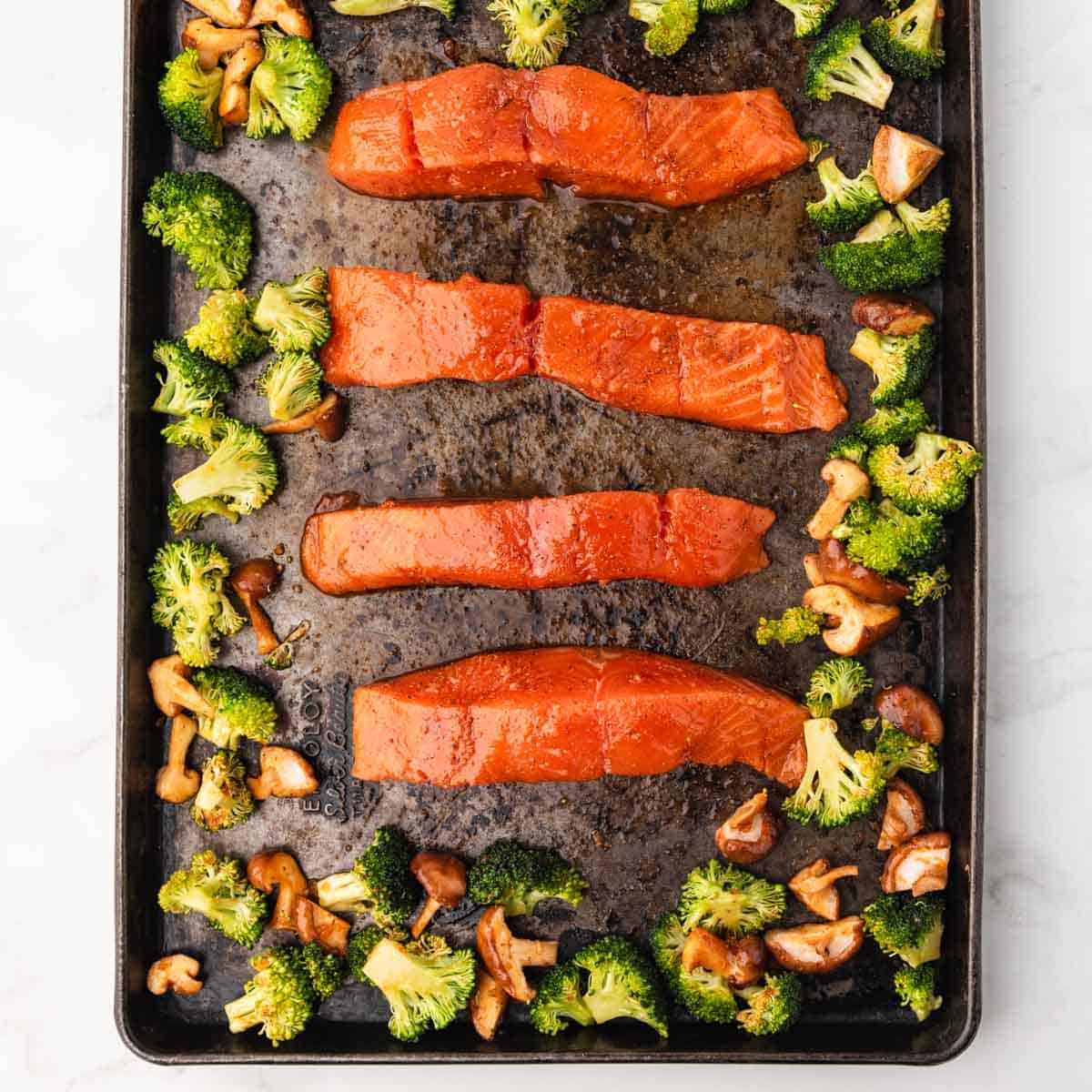
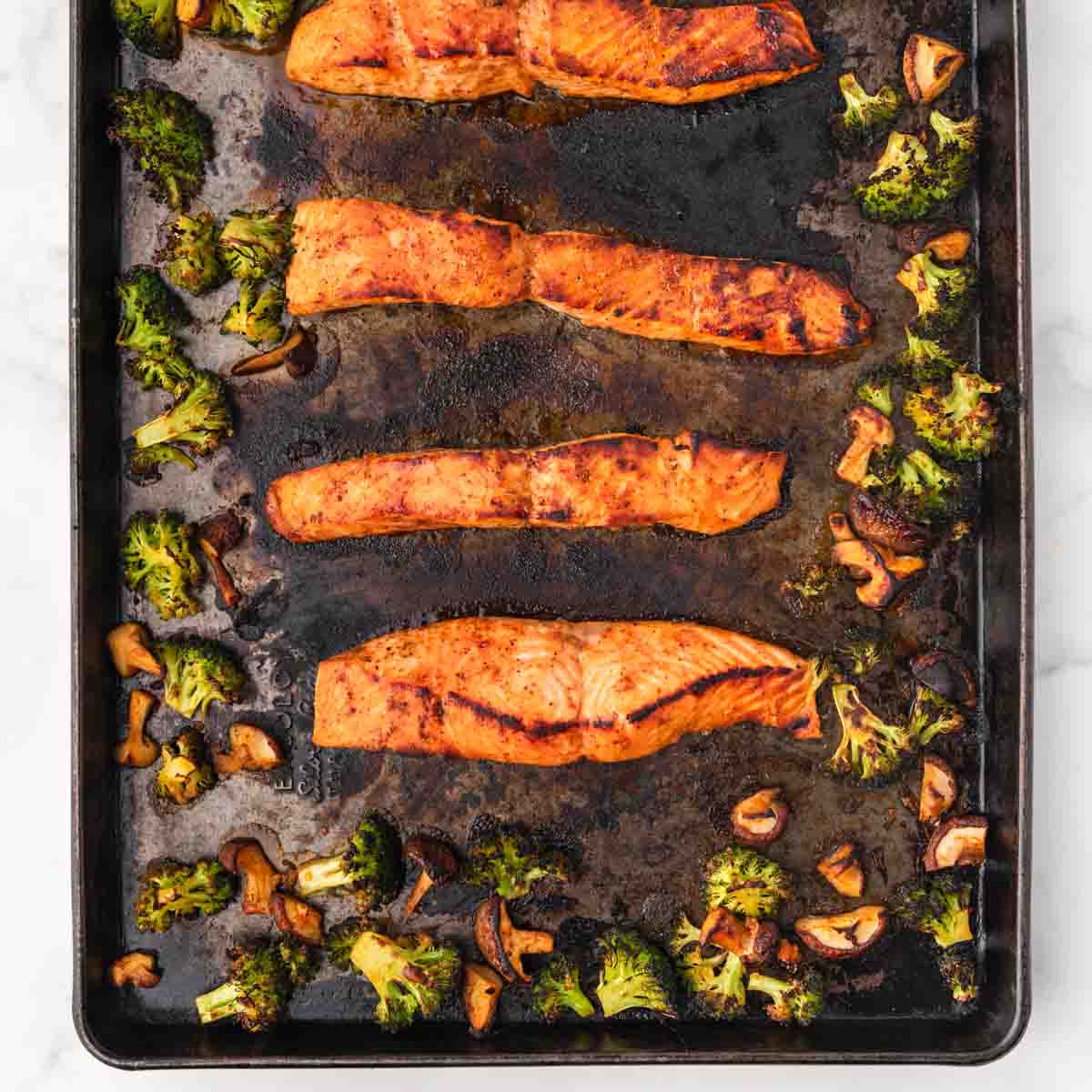
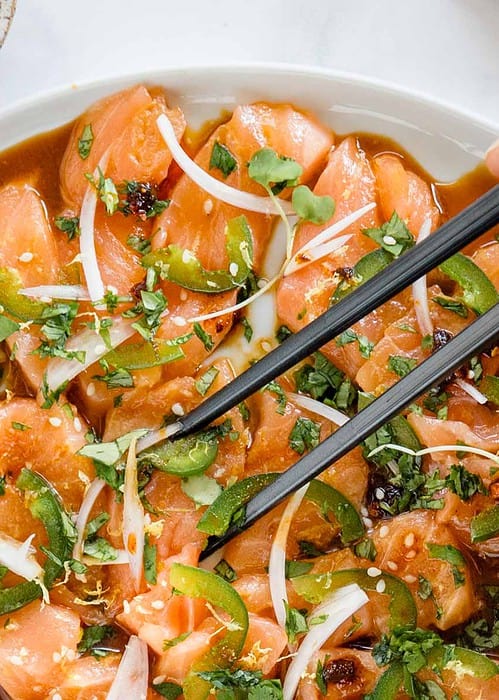

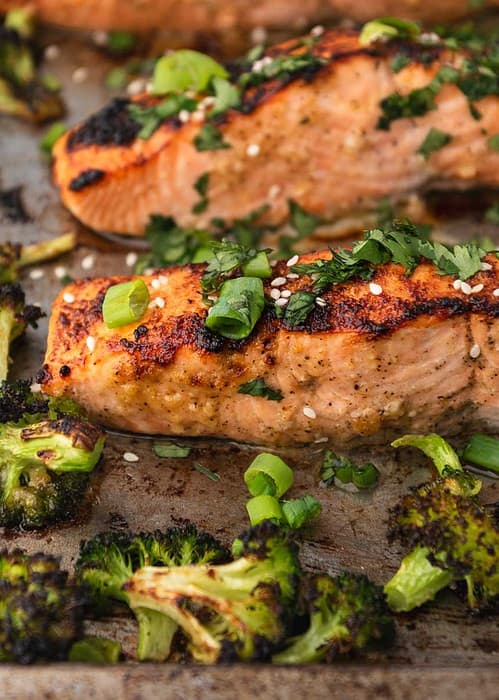
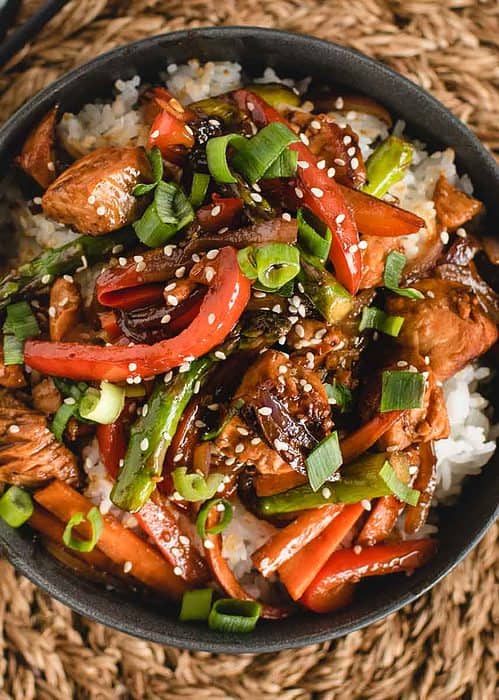
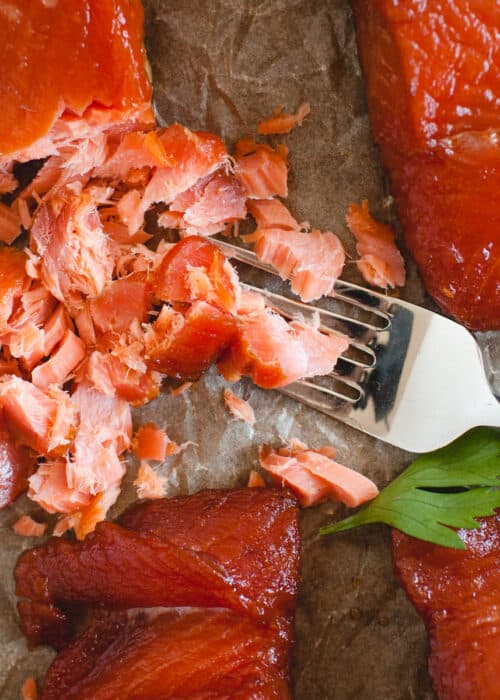
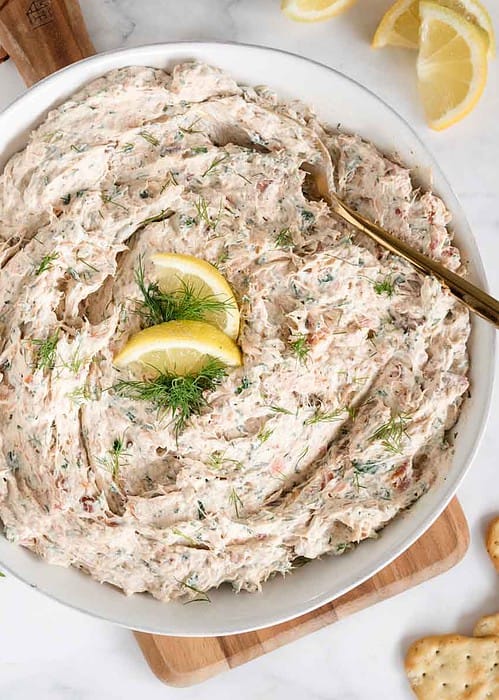
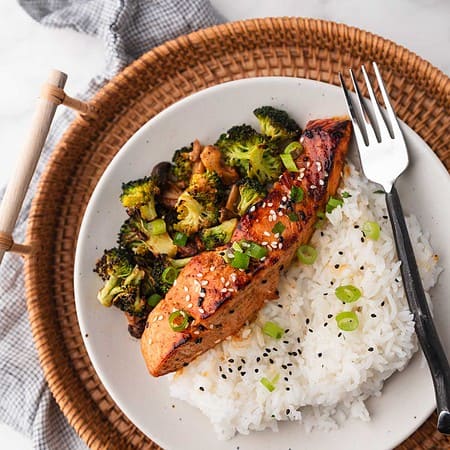








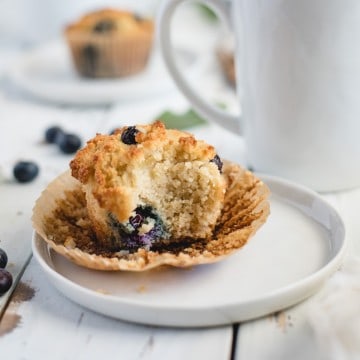

Comments & Reviews
This recipe is fantastic! It’s so easy too and really did only take me 20 minutes. I used defrosted Costco frozen wild salmon and it turned out really moist and good. Next time I might let the salmon soak in the sauce for 10 minutes before broiling for a stronger spicier flavor or add more gochujang but I like things super spicy.
We really liked this one too Leanna! Gochujang spiciness can vary so much and I wanted to make sure it didn’t get too spicy for most people but yes, adjust that spice level upward if you can handle it. I like the heat too!